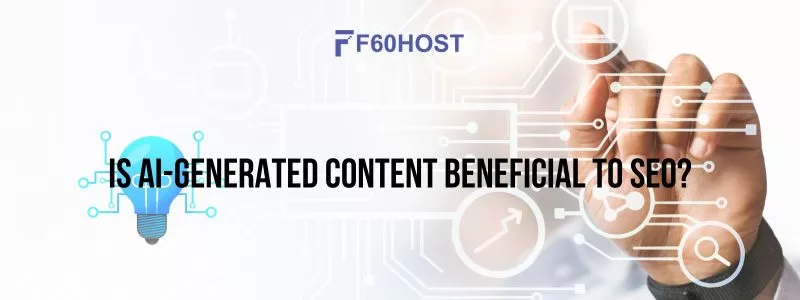Is AI-Generated Content Beneficial to SEO?

SEO is a procedure that increases the amount of search engine traffic that a website receives. Getting leads and turning those leads into sales is a crucial resource for contemporary firms. To make their websites easier to find online, several companies have already optimized them. However, given the popularity of AI-generated content, companies need to reevaluate how SEO and this content are related. In this post, we investigate the potential effects of AI-generated content on SEO and offer advice on how to make the most of these tools.
What Is AI-Generated Content?

Images produced by artificial intelligence (AI) are referred to as AI-generated images. Increasingly more people are using this style of photography because it might appear distinctive and lifelike. We’ll delve deeper into what AI images are and how they’re made in this blog.
How does AI work?
Artificial intelligence is referred to as AI. This is a reference to a computer that can mimic or at least imitate human intelligence. It is complicated, as it sounds complex: An AI system can access enormous volumes of data and uses sophisticated algorithms to analyze it. This is how it picks up patterns and problem-solving skills. There are various ways that an AI can be “intelligent”: Simple systems can only identify simple practices, such as those seen in texts or photographs. Modern systems, on the other hand, are able to handle tough jobs, like driving a car.
The Importance of SEO in Digital Marketing
Search engine optimization (SEO) is the process of enhancing content’s visibility in search engine result pages (SERPs). Higher search ranks result in more organic traffic and brand visibility, making it a crucial component of digital marketing. Businesses spend a lot of money on SEO tactics to acquire a competitive edge and successfully target their customers.
Exploring the Intersection of AI Content and SEO
Evaluating AI-generated content’s compatibility with SEO goals is crucial as it grows in popularity. Can AI content successfully raise search engine rankings and have the intended effects? This article explores the potential advantages and disadvantages of AI-generated SEO content to clarify this subject.
Types of AI-Generated Content and Their Definition
Artificial intelligence (AI) is used to create content for you. Written material like blog posts, marketing copy, and articles are frequently described as AI content. Human input is needed for AI content generators, such as a description, a prompt, or parameters.
4 Types of Artificial Intelligence
- Reactive Machines
- Limited Memory
- Theory of Mind
- Self Aware
The first type has long ago been perfected, and the second is still under development. The third and fourth classes now only live in principle. They’re to be the coming step of artificial intelligence; let’s look at them.
Reactive Machines
The most basic form of AI is the reactive machine type. It cannot make decisions in the present by using taught or recalled information; instead, it can only respond to current situations. Maps and other pre-planning tools are completely eliminated in reactive machines, which concentrate on in-the-moment observations of their surroundings. They are only capable of performing the tasks that are assigned to them. When watching a robot compete against a human in a game like chess, you are more likely to notice them. But because reactive robots don’t interact with the outside world, they always react in the same manner to the same situations.
Limited Memory
Artificial intelligence comes in different forms. It alludes to an AI’s capacity for storing prior information and forecasts and utilizing it to produce more accurate forecasts. ML architecture gets a little bit more complicated when memory is constrained. Every ML model has a memory limit when it is generated, however, it may be used to deploy a reactive machine type, which is the most basic and straightforward form of AI.
Theory of Mind
The artificial intelligence of the Theory of Mind sort is still a ways off. Self-driving automobiles are an example of one of them, which are still in their early stages. In this sort of AI, artificial intelligence starts to communicate with human thoughts and feelings.
At the moment, machine learning models can accomplish a lot of work for a person. The current generation of A.I., Alexa, and Siri, follow instructions without question. It does not provide emotional support or state, “This is the fastest direction” if you yell angrily at Google Maps to send you in a different direction. Who can I call to let them know I’ll be late? Instead, Google Maps ignores your plight and keeps returning the same traffic updates and ETAs that it had previously displayed.
A Theory of Mind A.I. will be a better companion.
Studies in Artificial Emotional Intelligence and advancements in the Decision-Making theory have addressed this topic. The Future of ML and AI with Michael Jordan and Ion Stoica took place on May 13th, and Michael Jordan discussed part of his decision-making research there. More of it was covered at the ICLR 2020 conference.
There Are Some Other Types Of AI Tools
The tech-oriented crowd is aware of different forms of artificial intelligence. They have a similar structure but are talked about with a stronger focus on the applications, capabilities, and ways in which artificial intelligence advances humanity. They are as follows:
- Artificial Narrow Intelligence
- Artificial General Intelligence
- Artificial Super Intelligence
Regardless of how you slice it, artificial intelligence is a powerful software tool for the future that is here to stay. Artificial intelligence (AI) is removing monotonous duties from the workforce and uplifting people to become higher selves who embrace perpetual change and creativity. For such blogs, you can follow us on Twitter.



